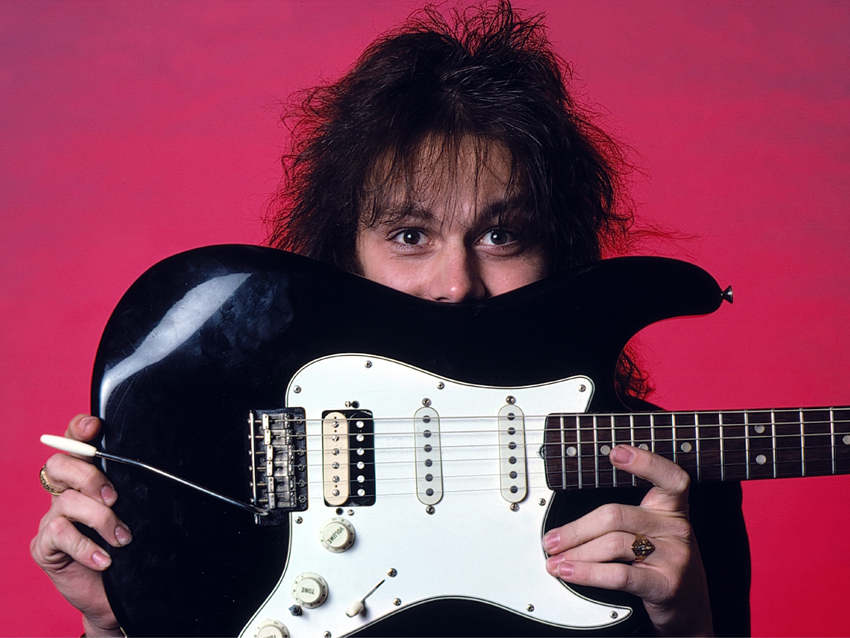
Strat fact of the day
60 DAYS OF STRAT: Whichever way you slice it, it's nothing short of phenomenal that the Fender Stratocaster, an instrument launched in 1954, is still being used today.
Sure there have been tweaks along the way, but the core of the thing, the Strat's soul, remains essentially unchanged. And that's worth celebrating, if you ask us.
So for the next 60 days, we'll be adding to this gallery and giving you a year-by-year fact-storm of all things Strat, from the key developments with the instrument itself to groundbreaking players, performances and much, much more.
So strap on your Strat and plug in for six decades worth of Fender goodness. It's going to get loud...

1954
The list price of a 1954 Stratocaster was $249.50 (or $229.50 without vibrato), plus $39.50 for a case. That's $2161.55 / $1988.28 in todays money, with the case costing a whopping $342.20.
At launch, the Strat was already a big ticket item – compare its price to a Telecaster ($189.50). a Gibson Les Paul Goldtop ($250 and a Gretsch Duo Jet ($230). Who says things were cheaper in the old days...

1956
Stratocaster marketing materials revealed that guitarists could select 'Player's Choice' colours when they ordered their Strat, for an extra 5% cost of course.
The colours were sourced from automobile paint suppliers Du Pont, whose nitrocellulose colours have since become synonymous with the Strat. Many of the finish names came from Du Pont in fact – Fiesta Red was first used on Ford Thunderbirds in 1956, while Lake Placid Blue was a '58 Cadillac colour.
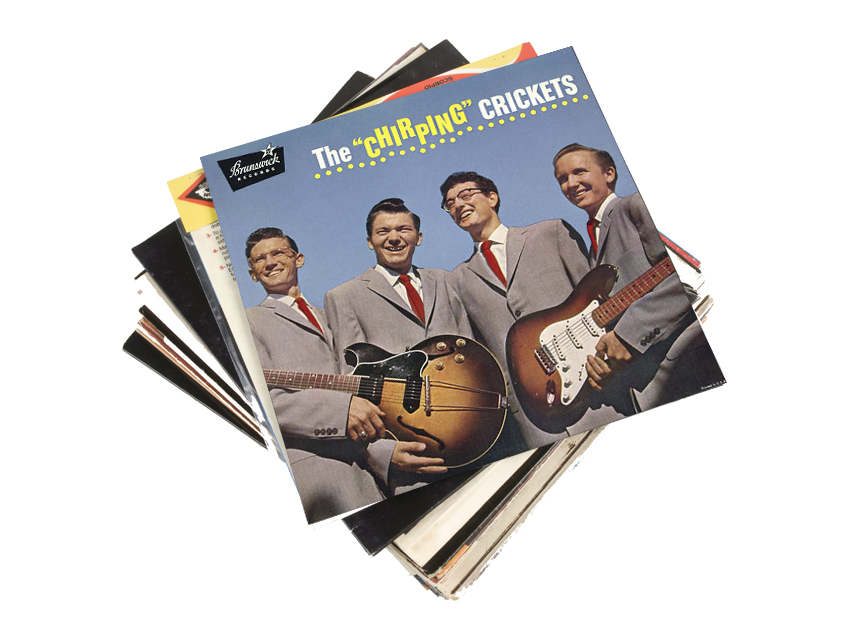
1957
The Strat became a star this year when it appeared on the cover of Buddy Holly and The Cricket's debut album The Chirping Crickets.
Holly's sunburst Strat also turned the heads of guitarists everywhere when he appeared on the Ed Sullivan Show in December '57, playing That'll Be The Day and Peggy Sue – both a defining moment for Holly and the Strat as they were beamed into homes across America.

1958
The two-colour sunburst finish switched to three-colour with the addition of an in-between red, and excitingly for aspirational Strat fans, the '58 catalogue was the first to show a full colour photograph of a custom colour Stratocaster: a gorgeous red guitar with gold hardware.
Over in the UK, a 12 year old Eric Clapton sees Buddy Holly on Sunday Night At The London Palladium, and sees his first Fender Stratocaster.
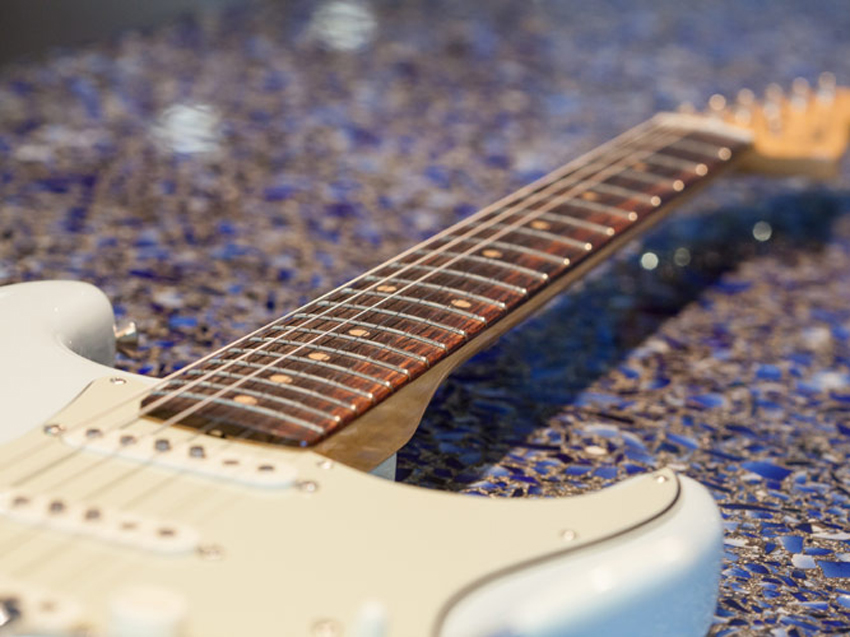
1959
Fender rang in the changes in '59, tweaking the Stratocaster design by adding Rosewood fingerboards and a three-layer pickguard that was fixed will eleven rather than eight screws.
In the UK, in the wake of an import ban on American instruments being lifted, Hank Marvin receives one of the first Stratocasters in the UK. It goes on to become forever associated with Marvin and his group, early instrumental rock and roll heroes (and Cliff Richard's backing band) The Shadows.

1960
The beginning of the new decade was a good year for Strats in the charts.
In the States, Buddy Guy cut his first single for Chess, The First Time I Met The Blues, using a '57 Stratocaster. Meanwhile across the pond Hank Marvin was putting his cherished red Strat to good use as The Shadows stormed the charts with Apache. Check out the mixture of knitwear, leather and Fenders they rock in the promo video...

1961
In the US, surf music sparked into life with Dick Dale Let's Go Tripping, an instrumental that showcased his distinctive use of the Strat.
A 1961 catalogue from UK distributor Jennings lists a Stratocaster at £147/17s/6d – that's £147.88/$400 at the time, and somewhere in the region of $3000 in today's money. That's a pretty penny by anyone's standards – Brits had to really want a Strat...

1962
Fender rolled in the changes on the Strat in '62, centring around the slab rosewood fingerboard.
The way the rosewood was married to the maple neck was altered with the rosewood now radiused. New neck widths were also introduced, coded A to D, with one thinner and two thicker than usual (B was the most common).
Elsewhere, a new vocal harmony combo fresh out of California called The Beach Boys made their debut TV appearance alongside two brand new Strats. Looking fresh, boys...
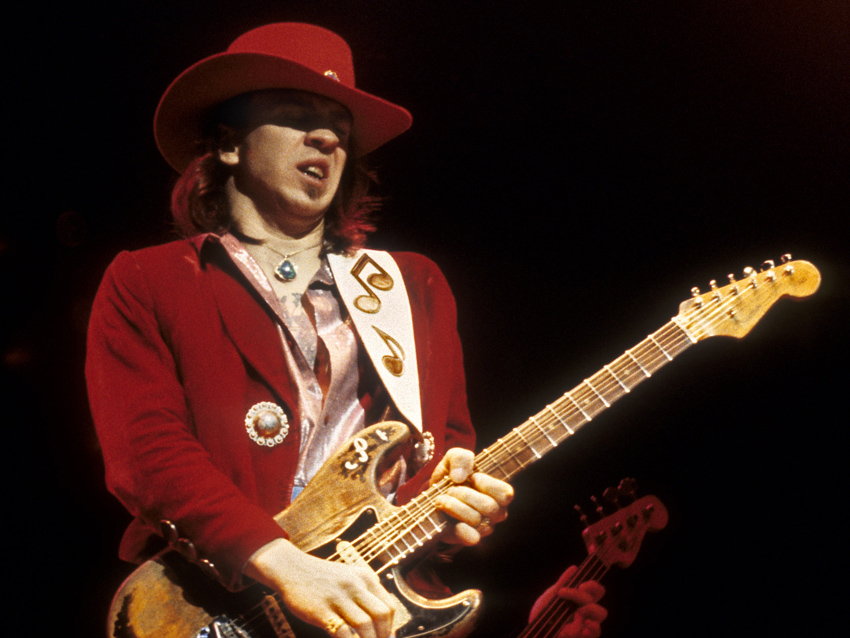
1963
1963 was a great year for the Strat. The changes from the previous year had settled in, and Fender's production lines were firing on all cylinders.
Which is probably why Strats favoured by some serious players were born that year. Stevie Ray Vaughan's fabled Number One was born, and Hendrix owned at least one Strat from '63. Check out SRV making Number One sing in the first part of this sound check (!) video below...

1964
In the year that The Beatles broke America, the Strat went through a number of changes to its decade-old design.
Most noticeably the early ‘spaghetti’ style Fender logo, an elegant and much-loved early design, was swapped out for the thicker ‘transition’ logo designed by Fender’s graphic designer Robert Perine.
By the end of the year, Fender had also done away with the clay dot markers on the neck (replacing them with Pearloid) and changed the pick guard material so that it was no longer made from the mint-green celluloid that has become synonymous with early Strats.

1965
This was the year that changed it all for Fender, with CBS buying the company for a whopping $13million dollars – that’s $97.5million in today’s money, an indication of the value the brand had built up in little over a decade.
1965 also saw one of the most controversial uses of a Stratocaster ever, as Bob Dylan went electric at the Newport Folk Festival with a Strat round his neck. That guitar was auctioned off for $965,000 in 2013, making it one of the most valuable Strats in the world.

1966
This was the year that the Stratocast met the man that was destined to change its fortunes forever, Jimi Hendrix.
Hendrix picked up his first Strat, a white '64 model with maple neck and rosewood fingerboard, from Manny's Music in New York. He bought it with money borrowed from a girlfriend for the princely sum of $289.
Elsewhere in the US, in South Raymond to be precise, CBS completed the construction of a new $1.3million Fender factory as the new owners geared up for increased production runs. They were going to need the new facility, and soon...

1967
'67 was a year for significant Strats, and some of the most iconic performances ever to use Leo's masterpiece.
Only a year after buying his first Strat, Hendrix went about systematically destroying them. He first burned a Strat on stage at the London Astoria on 31 March, and although he was left hospitalised with minor burns, he still pulled the same trick again at the end of his set at Monterey Pop in June.
Finally, George Harrison showcased his psychedelic Rocky Strat during The Beatles' controversial Christmas Day TV premiere of Magical Mystery Tour. You can see Rocky in all its glory during the performance of I Am The Walrus.

1968
Post-CBS, there were more changes with the Strat this year - and not entirely positive ones. '68 was the first year that Fender started using thicker polyurethane finishes as opposed to the much loved nitrocellulose lacquer that had been used up to then.
Elsewhere in '68, David Gilmour bought his first Strat shortly after joining Pink Floyd, although his famous Strats - both the 0001 model and the Black Strat - were still to come.
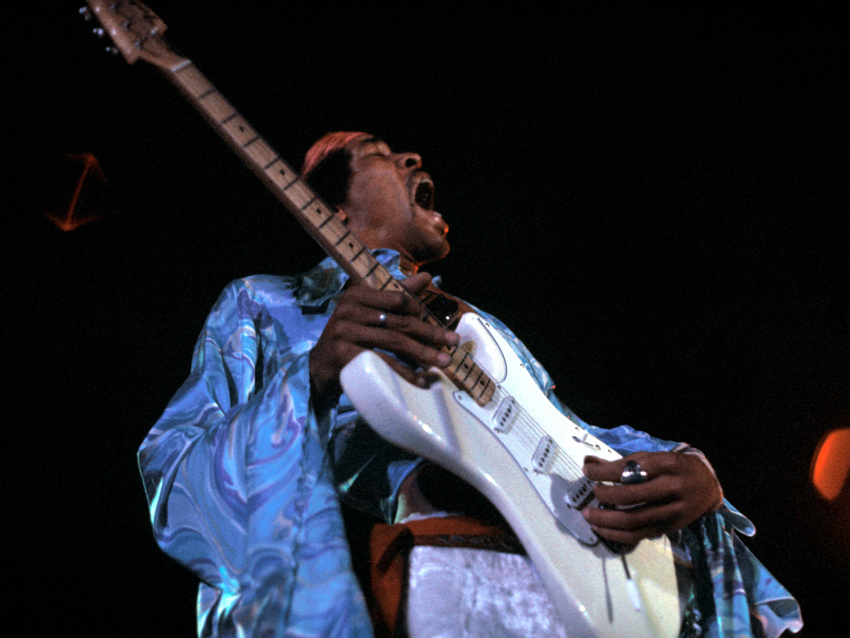
1969
The '60s ended on a sad note for Strat fans as Leo Fender left Fender when his five year retainer from CBS ran out. It wasn't to be the end of Leo's love affair with the guitar, but he would never again work for the company that bore his name.
'69 also saw arguably the greatest Strat performance of all time as Jimi Hendrix played Hendrix. A truly iconic moment in rock and roll history, the best possible thing you can do is simply watch the master at work:

1970
Visiting Nashville while on tour with Delaney and Bonnie, Eric Clapton picked up a handful of second hand Strats for around $100 each, picked the best parts and cobbled together one of the most famous Stratocasters ever: Blackie.
Consisting of a deep V shap '57 neck, a refinished black '56 body and various pickups, Clapton's new Strat would be his main guitar until the mid '80s. He'd go on to sell it at auction in 2004 for $959,000 to Guitar Center.

1971
Some of the most controversial CBS era changes appeared in the Strats that rolled off the production line this year.
First up came a truss rod change, which saw the debit of the bullet adjuster in the headstock. An adjustable neck tilt, accessible from the new-style neck-plate, was also introduced.
George Harrison favoured a white Strat throughout his epic charity fundraiser Concert For Bangladesh. Watch George show how it's done on Beware Of Darkness:

1972
A record year for the Strat, 1972 saw both unit production and dollar sales higher than ever before as the popularity of the Strat soared to new heights.
Guitarists were still finding new uses for it as well. Curtis Mayfield used his Strat to devastating effect in Superfly, released this year and about as great an example of Strat-driven groove as is ever likely to committed to tape.

1974
A major expansion program at Fender's Fullerton plant was completed this year, expanding Fender's production facility to a whopping 289,600 square feet of production, warehouse and shipping space – enough to keep up with the phenomenal demand for Strats.
The catalogue from '74 reveals that the CBS years had seen a decrease in the options of Strats availabe – you could only pick one up in six colours, sunburst (at $405), blond, black, white, natural and walnut (all at $425).
Meanwhile Rory Gallagher released his seminal album Irish Tour '74, showcasing his legendary road work Strat, and there was much rejoicing.

1976
The Band called it a day with an epic final performance in the form of The Last Waltz, and guitarist Robbie Robertson turned heads with an eye-catching bronze Strat.
One of the more exotic Strats out htere, Robertson also moved the middle pickup nearer to the bridge so that he wouldn't hit it when playing with finger picks.

1977
Fender finally upgraded the Strat's pickup selector form a three-way to a five-way switch, after years of guitarists doing fiddling with their Strats to access the 'in-between' tones.
1977 was also the year of the Antigua finish, a Custom colour that was initially designed to cover up factory blemishes, was resurrected for the Strat and injected some much-needed colour into Fender's late '70s line-up.

1979
The Strat hit a quarter of century in '79, and to celebrate Fender launched a 25th Anniversary Stratocaster.
Released in limited numbers, it featured Sperzel machineheads, a chrome stamped neck plater, maple neck and 'anniversary silver' finish. It came with a certificate of authenticity too, in case the big 'anniversary' stamped on the upper horn wasn't enough to remind you of its special provenance.

1980
The beginning of a new decade saw the introduction of The STRAT.
That's right, in 1980 Stratocaster was a little too unwieldy a name so Fender trimmed it, altered the headstock, threw in a set of overwound X-1 pickups and gold plated the hardware. And just to reinforce the high-end vibe, a premium price tagged on too...
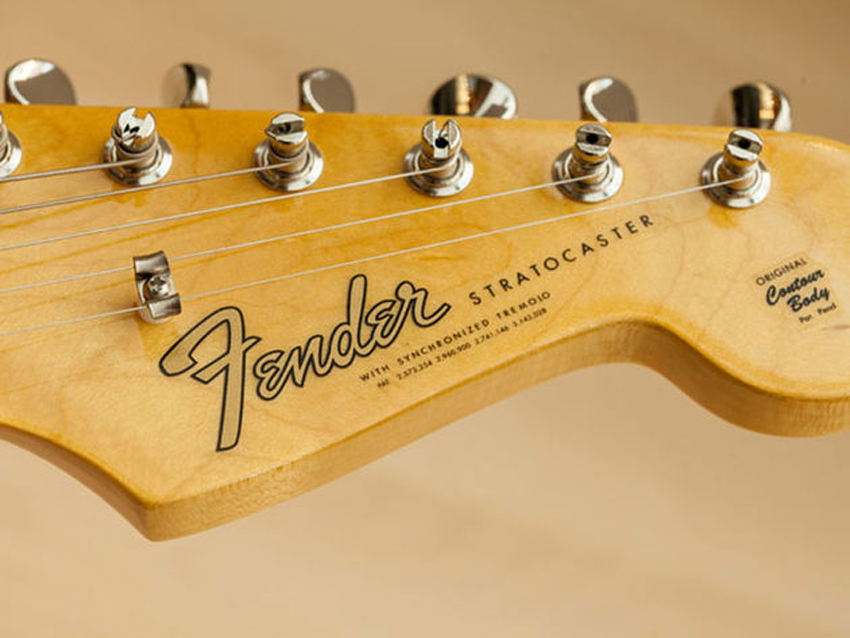
1981
After years of decline, CBS set out to turn Fender around.
They recruited new managed, including the now-legendary William Schultz, William Mendello and Dan Smith. Shultz became president, and Smith took over as director of marketing. Within the year, they'd kick-started a plan that was to lead, eventually, to a resurgence in quality and a renaissance of the brand that birthed the Strat.

1982
In late '81, Dan Smith overhauled the standard Stratocaster, introducing a new Strat that took the guitar back to its early '60s spec.
The now much sought after Dan Smith Strats features the smaller, pre-CBS style headstocks, no bullet truss rod adjustment at the nut and a general upswing in production quality. The return to the company's traditional values weren't to last, however...

1983
There were a pair of new Strats thrown in to the mix this year, and both of them pushed the sacred Strat formula a little too far.
First up was the Stratocaster Elite, an attempt at up-market refinement that replaced the pickup selector switch with push buttons. It was an attempt to modernise that missed the mark, but worse was still to come.
In a barbaric act of CBS cost-cutting, the standard Stratocaster was redesigned to include a flat input and only two controls. It looked just as bad as it sounds, and was received poorly by players everywhere.
Meanwhile, Eric Clapton went all Dali on us and included a melted Strat on the cover of Money And Cigarettes.

1984
While Fender's fortunes on the production side were faltering, there was still plenty of life in the Stratocaster, which was finding a new lease of life in the hands of a new Strat superstar in '84: Stevie Ray Vaughan.
The Texan bluesman released his second record with Double Trouble in May, Couldn't Stand The Weather, and sold out Carnegie Hall later in the year. Stevie Ray Vaughan was making serious waves among guitarists, and was proving there was plenty of life in old Strats yet...

1986
In the wake of the CBS sale, the new Fender management established a new factory at Corona, California, and set about bringing the Strat back to basics with the launch of the new American Standard series.
The new Standard Stratocaster took the best of the original design and added in a 22 fret neck, a flatter fingerboard, tweaked vibrato and flat stainless steel saddles. The new Strat was available in Arctic White, Black, Brown Sunburst, Gun Metal Blue, Pewter and Torino Red, and signalled a sea change in the Strat's fortunes.

1987
Fender established its Custom Shop at Corona this year, specifically to build one-off and signature guitars, with the Haynes Limited Edition Stratocaster one of the first models produced.
Meanwhile an original – and tragic – Strat hero was remembed as La Bamba, the story of Ritchie Valens, hit the cinemas. The lead single from the film, Los Lobos' version of La Bamba, became a worldwide smash, and there was a Strat front and centre in the video.

1988
Fender's first ever widely available signature model, the Eric Clapton Stratocaster, went into production in '88.
After retiring his famouse Blackie Strat in '87, Clapton spoke to Fender about a new guitar. His Signature Strat featured a deep V neck, Lace Sensor pickups and a mid-boost circuit, and the Clapton Strat was an instant hit, paving the way for the hundreds of signature models that have followed since.
In fact, in the same year Fender followed with another signature model, the Yngwie Malmsteen Stratocaster, which featured Malmsteen's famed scallopedfingerboard.

1989
Hair was big and solos were shreddy in 1989, and Fender didn't want to be left out of the fun.
And so, the HM Strat was born (the HM standing, presumably, for Heavy Metal and not Hairy Mother), a US-made superstrat with a revamped body shape, locking vibrato, 24-fret maple neck and deep cutaways, as well as a radically altered headstock and logo.
The HM Strat didn't last long, but both the instrument and the associated marketing materials are about as '80s as it is possible to get.

1990
A familiar Strat came up for auction at Sotheby's in London in April: a white 1968 Fender Stratocaster that had been played by Jimi Hendrix at Woodstock.
Bidding on Jimi's legendary Strat started at £48,000, before finally selling to the co-founder of Microsoft Paul Allen for a whopping £198,000 - a record breaking amount at the time.
It wasn't all about Jimi in 1990 though. New Strat hero Eric Johnson broke through with his album Ah Via Musicom, proving once again that the possibilities for Strat sounds were endless.

1991
Thirty six years after he invented the Stratocaster, Leo Fender passed away on 21 March 1991.
The Fender founder left behind him a musical legacy that continued to evolve way beyond that which anyone could have conceived of when the Strat made its debut.
You need only look to the big Strat record of the year, Red Hot Chili Pepper's massive breakthrough Blood Sugar Sex Magick, in which John Fruciante pushed Leo's design into ever stranger and funkier territories. Don't believe us? Check the video below out...

1992
Fender unveiled its new Texas Special single-coil pickups this year, and they made their debut on the new Stevie Ray Vaughan signature Strat.
The tribute model had been agreed before the guitarist's death, and was a replica of SRV's Number One Strat, and featured specs of a '59 Strat with a '62 style neck and a left handed vibrato.
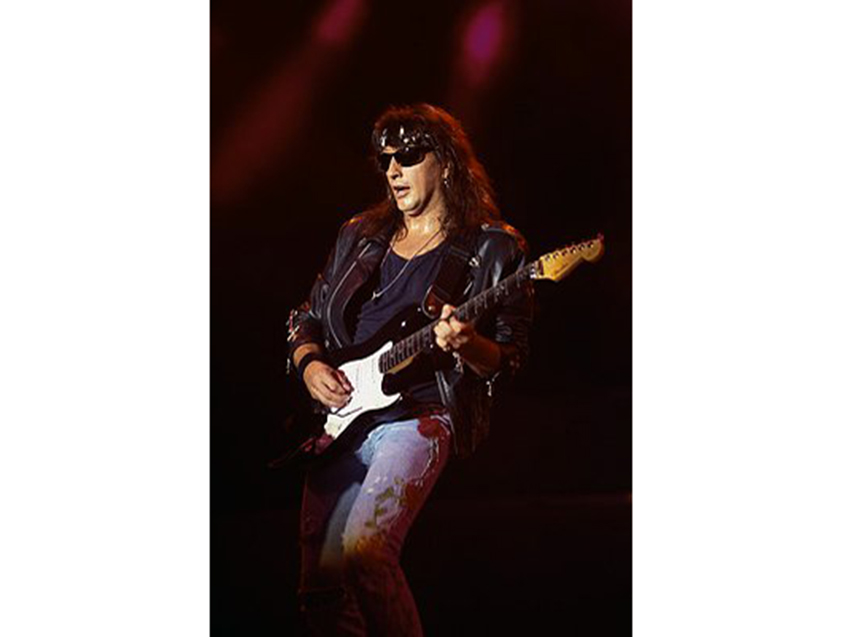
1993
More signatures arrived this year,including the Richie Sambora Strat. The Bon Jovi guitarist's model features a Floyd Rose, a DiMarzio humbucker at the bridge and a pair of Texax Special single coils.
Fender also released a limited edition Harley-Davidson 90th Anniversary Commemorative Stratocaster, to the delight of musical bikers everywhere.

1995
'95 was a big year for the Stratocaster. First up, Bonnie Raitt became the first woman to get a signature Strat, and secondly a phenomenon was born: Relicing.
When Keith Richards asked the Fender Custom Shop to build a couple of guitars for him to use on tour with the Stones, he complained that they looked too new. 'Bash 'em up a bit and I'll play 'em,' said Keef, and lo, the Custom Shop began distressing guitars.
The new Relic series was announced in 1995, with three Relic Strats and a Relic Nocaster on offer. Nearly two decades later, the hunger for reliced guitars has yet to abate...

1996
Richie Sambora bagged himself another tasty looking signature this year, in the form of the Japanese built Black Paisley Strat, a limited edition model that's highly sought after today.
Elsewhere, Fender launched the Lone Star Strat, which took the American Standard and added a humbucker at the bridge and a pair of Texas Special single coils into the equation – an winning formula that's still in production at Fender today as the Lone Star Deluxe.

1997
Fender went Hendrix mad in '97, releasing two models celebrating Jimi's legacy.
First up was the Jimi Hendrix stratocaster, which was essentially a reversed left-handed '60s spec Strat, rejigged to give right-handed players the feeling that they'd reversed their Strat just like left-handed Jimi had to. In a truly bizarre move, they even reversed the headstock decal, so that it only read properly in the mirror.
Next up came the Hendrix Monterey Strat, which recreated the hand-painted artwork of the instrument that Hendrix played at the Monterey Festival in 1967, and looked very nice, if you like that sort of thing (which quite a lot of people did).

1998
Fender's US Vintage series transitioned to the American Vintage series in '98, bringing the '57 and '62 model Strats back as close to the original specs as possible.
Fender re-shaped bodies, re-wired pickups and went all-out to recapture the vibe of those groundbreaking early Stratocasters. It worked, too - the American Vintage series is still an integral part of the Fender range today, and continues to be popular.
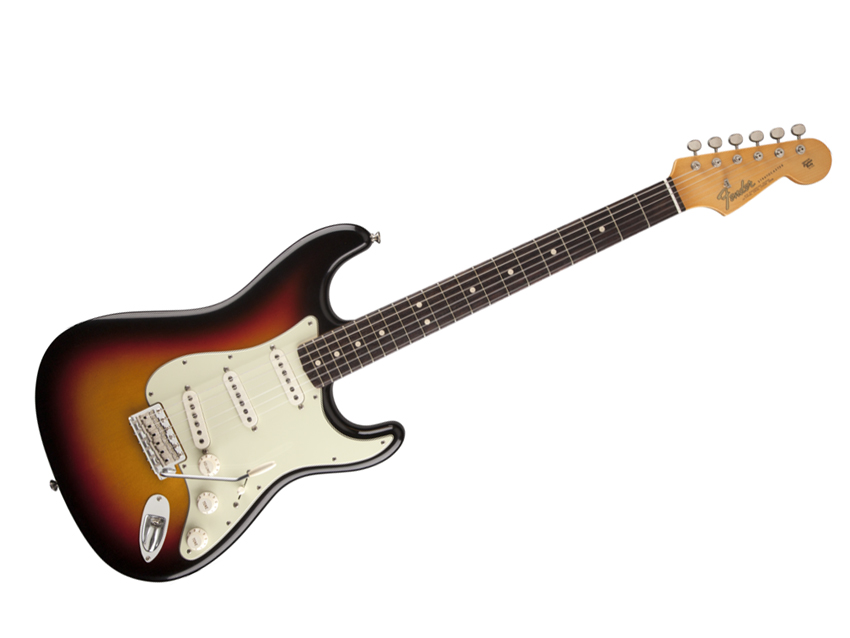
1999
Not one, but two – count 'em – new Stratocasters launched this year, and there was much rejoicing.
Both came out of the Custom Shop, and followed the trend for instruments that had the vibe of vintage guitars. First up was the Closet Classic, which was made to look as it it had been bought back in the day, played once or twice and then stuck in the closet for decades.
It was joined by the NOS, or New Old Stock, line, which was essentially Fender's very own time machine, creating guitars that looked like they'd been bought way back when and magically transported to the present.

2000
Humbucker fans finally got their wish at the turn of the millenium as Fender finally unveiled a Stratocaster with no single coils at all.
The Double Fat Strat featured a pair of Seymour Duncan humbuckers, and wasn't destined to last long – although it's a model that still has fans in certain quarters.

2001
Blink-182's Tom Delonge teamed up with Fender in '01 to put together one of the most stripped back signature Strats ever.
With a single Seymour Duncan humbucker at the bridge and a single volume control, alongside a '70s style headstock and a Surf Green finish, it was simplicity in guitar form.
Delonge wasn't the only Strat-wielder making waves this year though. The Strokes broke through, and
guitarist Albert Hammond, Jr. propelled the reinvigorated sound of New York cool along with a white Strat.

2003
John Mayer released his second album, Heavier Things, and was pictured on the cover with his favourite battered Strat (and a pair of baggy cargo trousers, but we'll let him off).
Meanwhile Fender added the S1 switch to a couple of Strat models, adding even more switching options to the HSS and HH Strats.

2004
The Stratocaster hit the big 5-0 in '04, and celebrated with a huge birthday concert in London starring Dave Gilmour and his fabled 0001 Strat.
Fender also unleashed four 50th Anniversary Stratocasters, including a painstakingly detailed Custom Shop replica of a '54 Strat, an American Deluxe and American Series 50th Anniversary Strat, and a Mexican made 50th Anniversary Golden Stratocaster, finished in deliciously opulent Aztec Gold.
Finally, Eric Clapton said goodbye to his legendary Blackie Strat this year. He'd assembled it from parts in the early '70s, and it was sold at Christie's in New York City for a whopping $959,000. Not bad, Eric, not bad at all...

2005
Another Strat hero was born this year as Arctic Monkeys released their debut album, Whatever People Say I Am, That's What I'm Not.
Frontman Alex Turner's white Strat was his main guitar as Monkey mania swept the UK, making Leo's slice of design genius look desirable to a whole new generation of rock and rollers.

2006
The new owner of Eric Clapton's famed 'Blackie' Strat lent it to Fender's Custom Shop so that the guys there could replicate it down to the exact detail.
The Custom Shop Blackie Strat was incredibly popular, an instant smash hit – to the extent that Guitar Center sold 106 of them in under two minutes.

2008
The American series was once again renamed, this time to the American Standard, and this time the name stuck. Fender upgraded the range with new finishes, improved bridges and a host of other tweaks to its flagship guitar.
In sad news, the man who named the Stratocaster, former Fender employee Don Randall, passed away in '08, signalling the end of an era for old-school Fender fans.
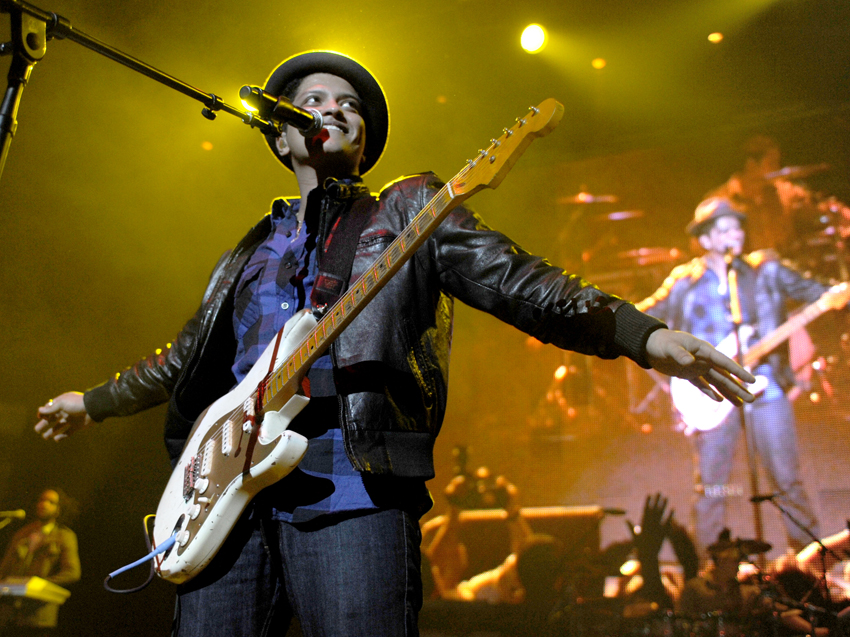
2010
NAMM is always a hotbed of Strat-based activity, and 2010 was no different as Fender launched the American Special Stratocaster.
Designed to bridge the gap between the American Standard and Highway One models, the American Special was designed with the 'working man' in mind – an affordable, high-quality, pro-spec Strat for the children of the debt crisis.
Meanwhile, confirmed Strat fan Bruno Mars released his debut album, and was seen strumming away on a selection of fine Stratocasters all over the place as he promoted the record.

2011
Fender unleashed a tribute to perhaps one of the most striking Strats ever in the form of the Wayne Kramer Stratocaster. Just look at it – an absolute beast of a guitar, and well suited to the MC5 guitarist.
Elsewhere in the Fender product lines, relicing proved as popular as ever, and the new Road Worn Player Series added new specs to the popular, Mexican-made range of pre-battered Strats for the masses.

2013
There were a ton of new Strats introduced in '13, including a rather natty Ritchie Blackmore Tribute Strat that perfectly replicated the riff machine owned and played so singularly by the Deep Purple guitarist.
Fender also announced a Humbucker-loaded Select Stratocaster, which sported a tasty flame maple top, and the unusual but alluring Pawn Shop Series '70s Strat Deluxe.

2014
And so, our celebration of all things Strat reaches 2014, 60 years since Leo's stroke of design genius first appeared and blew the minds of guitarists everywhere.
As you'd expect, Fender celebrated the Stratocaster's big 6-0 in some style, with not one but three Aniversary Models. The new guitars included the 60th Anniversary American Vintage '54 Stratocaster, which replicated those first, earth-shattering Strats, the 60th Anniversary American Standard Commemorative Stratocaster and the 60th Anniversary Classic Player 50s Strat.




